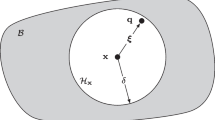Abstract
Constraints typically arise from the elimination of high frequency oscillations in mechanical systems. Examples are provided by bond constraints in molecular simulations and incompressibility constraints in fluid dynamics. A key issue is the accuracy of constrained dynamics with regard to the full dynamics. In this review we focus on the smooth solution components and discuss the concept of slow manifold and soft constraints in molecular and geophysical fluid dynamics. While the formal mathematical derivation of constraints is the same for both molecular and fluid dynamics, the predominant numerical techniques for dealing with constraints are different in the two fields. Semi-implicit time- stepping methods are often used in geophysical fluid dynamics while explicitly enforced constraints are more common in molecular dynamics.
Similar content being viewed by others
References
E. Hairer, Ch. Lubich, G. Wanner, Geometric Numerical Integrators (Springer-Verlag, Berlin, 2006)
B. Leimkuhler, S. Reich, Simulating Hamiltonian Dynamics (Cambridge University Press, Cambridge, 2004)
F. Bornemann, Homogenization in Time of Singularly Perturbed Systems (Springer-Verlag, Berlin, 1998)
S. Reich, Physica D 138, 210 (2000)
G. Benettin, L. Galgani, A. Giorgilli, Comm. Math. Phys. 113, 87 (1987)
P. Echenique, C.N. Cavasotto, P. García-Risueño, Eur. Phys. J. Special Topics 200, 5 (2011)
R. Salmon, Lectures on Geophysical Fluid Dynamics (Oxford University Press, Oxford, 1998)
D.R. Durran, Numerical Methods for Fluid Dynamic: With Applications to Geophysics, (Springer-Verlag, New York, 2010)
J. Zhou, S. Reich, B.R. Brooks, J. Chem. Phys. 112, 7919 (2000)
R.D. Skeel, S. Reich, Eur. Phys. J. Special Topics 200, 55 (2011)
A. Robert, Jpn. Meteor. Soc. 60, 319 (1982)
P. Lynch, Large-Scale Atmospheric-Ocean Dynamics: Vol II: Geometric Methods and Models (Cambridge University Press, Cambridge, 2002), p. 64
N. Kopell, Physica D 14, 203 (1985)
D. Wirosoetisno, Adv. Diff. Eq. 9, 177 (2004)
S. Reich, Physica D 89, 28 (1995)
T. Schlick, Molecular Modelling and Simulation: An Interdisciplinary Guide (Springer-Verlag, New York, 2010)
N. Wood, A. Staniforth, S. Reich, Atmos. Sci. Lett. 7, 21 (2006)
B. Hess, H. Saint-Martin, H.J.C. Berendsen, J. Chem. Phys. 116, 9602 (2002)
T. Hundertmark, S. Reich, Quart. J. Royal. Meteorol. Soc. 133, 1575 (2007)
A. Staniforth, N. Wood, S. Reich, Quart. J. Royal. Meteorol. Soc. 132, 3107 (2006)
Author information
Authors and Affiliations
Corresponding author
Rights and permissions
About this article
Cite this article
Hundertmark, T., Reich, S. On the use of slow manifolds in molecular and geophysical fluid dynamics. Eur. Phys. J. Spec. Top. 200, 259–270 (2011). https://doi.org/10.1140/epjst/e2011-01527-7
Received:
Revised:
Published:
Issue Date:
DOI: https://doi.org/10.1140/epjst/e2011-01527-7




